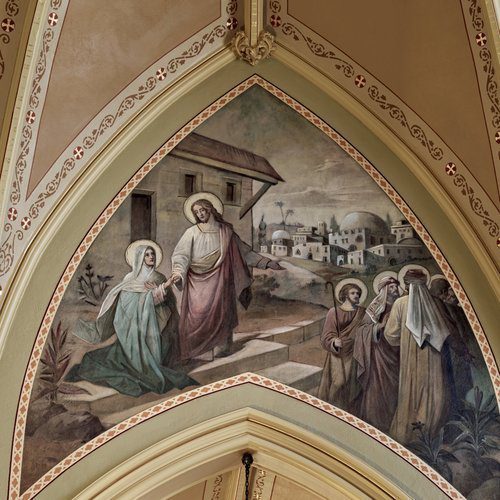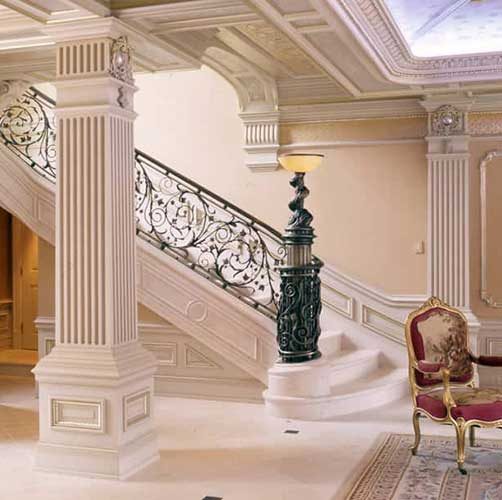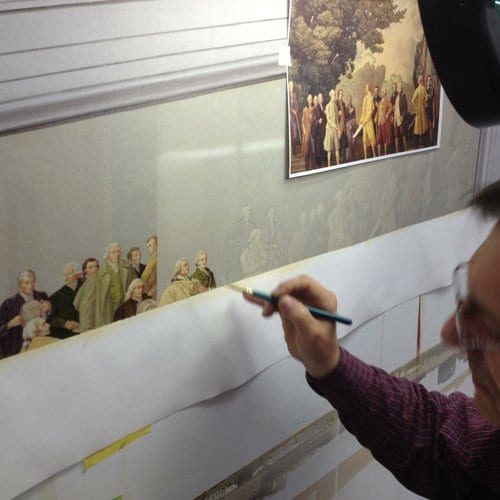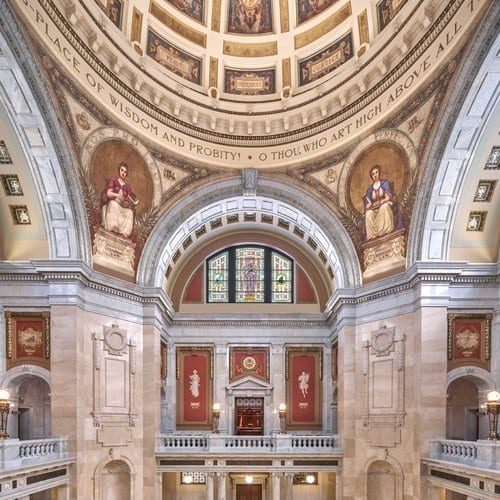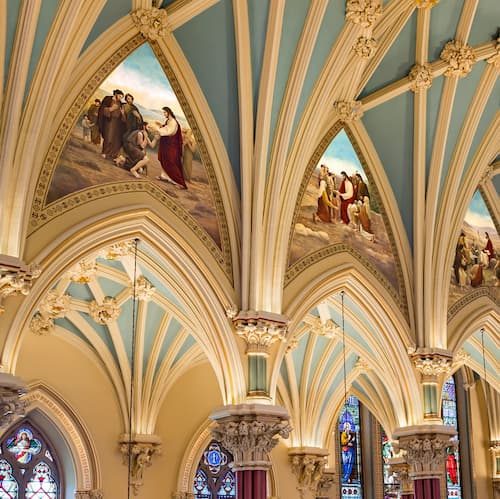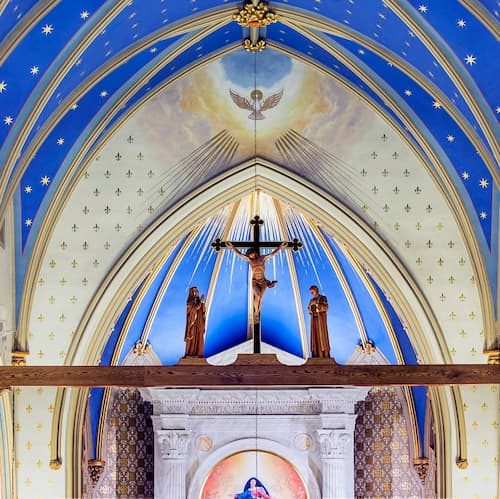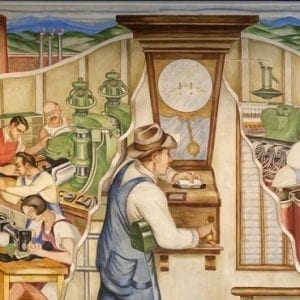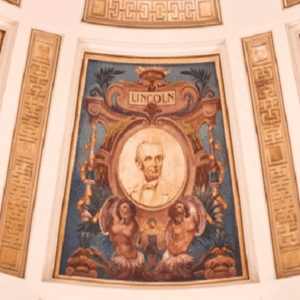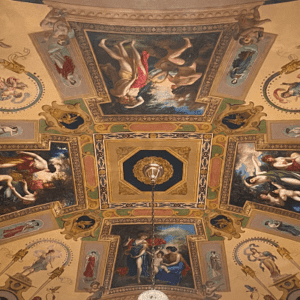Custom Murals & Commissioned Artwork
Enhance the beauty of your historic building or period interior with a custom mural or artwork that is faithful to the historic style and context.
Owners of historic buildings or period interiors can sometimes feel reluctant when it comes to creating a new mural or other painted artwork for their structure.
While the inclination to preserve historic integrity is an admirable one, the truth is there are many reasons why you should consider commissioning new art for your structure.
Maybe the original building did not have many (or any) decorative elements, but you have a desire to beautify the space in order to spark public interest.
Maybe one section of the building features decorative elements that were not originally carried into all spaces within the structure. Maybe the building itself is not historic, but a new construction in a historic style that you want to decorate according to that style.
At John Canning & Co., as specialty contractors, our expert conservators and artisans have decades of experience not only preserving, conserving, and restoring murals and artwork, but also in creating new pieces that align with the historic structure of the space utilizing period methods, materials, and techniques.
Is a paint analysis right for you? Speak with one of our preservation problem solvers.
Our Process
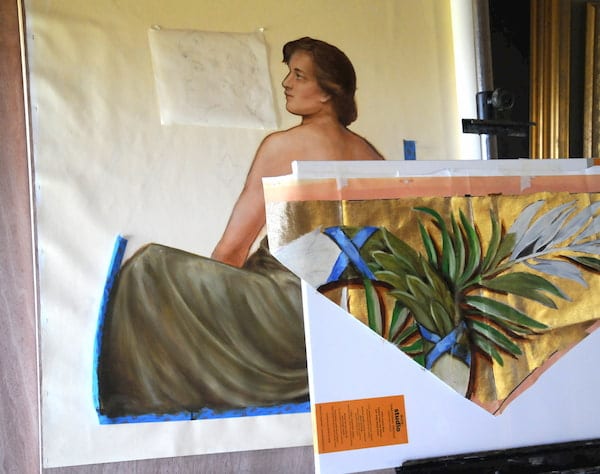 When it comes to creating new artwork that is going to live in a historic structure, a number of factors must be taken into consideration before any work is conducted.
When it comes to creating new artwork that is going to live in a historic structure, a number of factors must be taken into consideration before any work is conducted.
First, we must understand the goals of the engagement. Our team explores every aspect of what stakeholders are envisioning before starting any project. To better understand these elements, we ask some of the following questions:
- What does the owner or stakeholder hope to achieve?
- Is the engagement an attempt to recreate a piece of art that used to exist, but was lost in some way?
- Do they want the new artwork to match a style found elsewhere in the room or building?
- Is this simply an attempt to beautify the space?
- Does the owner or stakeholder have a design or motif in mind already?
In the case of historic buildings and structures, we must then understand the historic fabric of the structure. Our team meticulously studies all necessary historical information to match any existing or future elements to the correct time period and historic value. To understand these concepts, we will ask some of the following questions:
- When was the building constructed?
- Who was the architect or designer?
- Were there artists they typically worked with?
- If original period artwork or decorative elements exist elsewhere in the building, what style are they in, and what materials do they consist of?
- If the building does not have any original murals or artwork, what styles were common to the period that the building was constructed?
- Do any primary sources exist (photos, specifications, etc.) that can inform us on the history of the structure?
In cases of new construction, we must rely entirely on the owner or stakeholder for information about the building and intent of the artwork, as there are no primary sources to consult. In these cases, it is especially important to understand the planned use of the space (particularly for public spaces), as well as the style or period intent of the building. Additionally, knowing what other finishes and materials will be used in the space will allow us to create a mural that will feel cohesive with the rest of the design.
After this information has been gathered, our artisans will create an initial sketch and color palette to ensure that everyone is aligned on the content of the mural. At the same time, members of our team may conduct an analysis/survey of the underlying structure where the mural will ultimately live, in order to determine the condition of the structure and take accurate measurements if the artwork is to be executed on canvas. If necessary, actions may then be taken to stabilize the structure or otherwise prepare the surface for receiving the mural.
Once initial sketches are approved, the next step is to create a mockup, or maquette, of the artwork that will allow the owner and stakeholders to better visualize the completed work—for example, the ways in which lighting may impact the end result of the piece. Following approval of the mockup, final installation of the artwork can take place.
Our conservators are skilled in the recreation of notable styles and techniques of decoration such as:
- Chiaroscuro
- Byszantine
- Pre-Raphaelite
- Art Nouveau
- Hudson River School
- Plein Air
- Art Deco & WPA
- Realism
Using a variety of historic materials and methods, we are able to reconstruct and reinstate lost artwork or design new artwork that is respectful to the original artist. These include, but are not limited to:
- Complex Stenciling
- Pounced Cartoons
- Freehand Artwork
- Trompe L’oeil
- Simulated Stone (Faux Marbre)
- Wood Graining (Faux Bois)
- Gilding & Glazing
Cost Factors
The exact costs of painting a new mural in a historic structure will be dependent upon a number of considerations. These may include, in no particular order:
- The size and complexity of the work to be created, as well as the overall scope of the project if there are other factors at play
- Whether or not there are accessibility or safety concerns which must be accounted for (e.g., whether or not scaffolding will be required)
- Whether or not other types of assessment are necessary before new painting can begin (i.e., a historic finishes investigation of a different section of the structure to allow for paint matching, or a conditions survey to determine the quality and status of the underlying structure)
- Whether or not stabilization of the underlying structure must occur before creating the mural
For this reason, it can be difficult to estimate the cost of a “typical” project without understanding the specifics that it will entail. If you are considering commissioning a mural for your historic structure, we encourage you to contact us directly, which will allow us to give you a more accurate picture of what the costs of your project would be.
Our Specialties
We pride ourselves on our ability to create new murals and painted artwork that aligns with the historic integrity of a structure. To that end, we specialize in a number of complementary services which may inform this process or potentially form the next logical step after new mural creation is complete, including:
Selected Projects
We were able to uncovered original colors, patterns, and finishes to conserve 24 murals while restoring Stations of the Cross and the scagliola columns.
New design schemes and murals were created by John Canning & Co. for this opulent private home in Brookline, Massachusetts.
Our team was asked to assist with the design of a new mural of a shallow dome in the new visitor plaza, located below the Constitution exhibit hall.
We carefully conserved and restored all aspects of the Luzerne County Courthouses historic fabric: marble, metal, plaster, paint, and mural artwork.
Using a variety of gilding, transparent glazes, and metallic paint, our final product illuminates the sanctuary adding visual interest for the congregation.
We provided a new decorative scheme that articulates the architecture, reflects a Marian theme and represents the finest historical, traditional liturgical design.
“The firm’s knowledge of historic finishes, their attention to the minute detail of every feature, the consideration they give to all documentation of original features, from historic photographs to paint sampling, and their dedication to appropriate restoration are impressive.”
“Canning’s thorough knowledge of period decoration and methodology, as well as traditional materials, was a valuable contribution to the project team.”
“Finding remnants of original decorative patterns that had been whitewashed for 75 years. [John Canning Co.] restored them to their splendor and created a beautiful worship space for the present day community.”

